|
story and photos by BOB DORAN
Regardless, there's no denying that Eureka's little-known graffiti galleries harbor a surprising splash of boldly rendered images, shapes and lettering. Located in an overgrown section of marshland near the bay, not far from the beaten path yet essentially invisible to the general public, they constitute a true underground art scene. The galleries, the ruins of a once thriving bay-front lumber industry, are not literally underground -- although when you are standing on the floor of the pit, the open-air basement of an abandoned mill, you are below ground level. As for the tunnels, they aren't tunnels at all but small, open-ended enclosures, crumbling but colorful -- former sawing sheds, most likely -- that you can walk directly into. I came across the place accidentally, while on an excursion with birdwatchers and environmentalists. Some had seen the place before; no one seemed to know who might have made the art on the walls. All they knew was that it was some sort of graffiti. The word graffiti is Italian; originally it referred to scratching or drawing on rocks or walls. Graffiti was found on the walls of ancient Pompeii; you could say the form goes back to the dawn of human civilization, to the days when cavemen made records of their hunts on the walls of their homes. I recognized the work I had seen in Eureka as derivative of the hip hop graffiti style that was born in New York in the '70s and '80s along with rap music, DJ culture and break dancing. The form has evolved since then, and it's not uncommon to see whole walls covered with intricate lettering compositions in urban areas like San Francisco, Oakland or Los Angeles; but I had never seen graffiti quite this refined in Humboldt County. The work was compelling and, in its own way, beautiful. Journal art critic Linda Mitchell feels that graffiti is definitely an art form. "The best of it can be very sophisticated aesthetically," she said, "with elaborate compositional arrangements and bold uses of color and line. And in a way, there's also a real purity to the art form, since it's rarely intended to be permanent or displayed in traditional venues. These artists create on their own terms, inventing and refining their visual language and methods of expression as they go." Of course, beauty is in the eye of the beholder, and to some graffiti is a blight, particularly the ubiquitous "tags," crude signatures that pop up on walls and any other available surface in cities all over the world. Some Eureka residents were shocked to learn recently that a rash of tags on the west side of town was gang-related and perhaps indicative of growing criminal activity. Two recent high-profile arrests for graffiti vandalism in Arcata have brought the problem into sharper focus in that community as well. My suspicion was that the art I saw in the pit was only loosely connected to the tags seen elsewhere in the area, and that it had almost no connection with gangs -- but how to find out? Since the law says graffiti is tantamount to vandalism, learning more about the artists, known in graffiti parlance as "writers," was not going to be easy.
My quest began with Peter Agoston, a local DJ who runs a hip hop record label with international distribution out of his Arcata apartment. He freely admits that 10 or 12 years ago, when he was a teenager growing up in Virginia, he was a tagger. "I would write my graffiti name on walls, alleyways, bathroom stalls. I guess I saw it as a form of expression, renegade expression. It was around the time I was teaching myself DJ'ing. And I was reading about, studying and honoring [graffiti] artists who crafted much more complicated pieces, the guy who `bombed' walls and trains in New York City. ["Bombing" is painting a large graffiti piece.] I was inspired to try it on my own. I was the SIK1, for Seriously Ill Kid -- that was my moniker." How does graffiti fit into hip hop history? The quick answer identifies the art form as one of the so-called "four pillars of hip hop culture" alongside rap music, DJ'ing ("scratching" records and other turntable manipulation to create a distinct sound) and break dancing, all coming out of New York's inner city. Graffiti writing first appeared in the `70s and early `80s as elaborate lettering on subway trains. Today, it has become an international phenomenon.
Why? "Primarily for legal reasons. Ninety-eight percent of the society looks down on graffiti. If you're an artist who's out writing all the time, they can track you down if they have your real name. The police view all graffiti as one menace, but it's not like that. The work you saw is an art form that has its own respective place." We arranged to meet at Rita's Taqueria on Wabash, a part of town that seemed to be awash with tags. A building at the corner off H and Wabash was covered with scrawls saying "Sur." When I pulled up to Rita's, the first thing I noticed was a bold graffiti tag, 2 feet high, spraypainted in black on the restaurant's outside wall. To my eye it was unreadable. Several shades of off-white paint beneath it suggested that the same space had been tagged and repainted more than once.
Both tags were a far cry from the complex paintings I had seen at the pit. As we drove toward the bay, Adhoc -- sporting a brown, crocheted stocking hat and yellow-tinted glasses -- explained the difference. "The piece on Rita's is purely individual," he began. "The writer is not claiming anything beyond his own name. You could say it's more artistic than the gang tags, but there's no real difference. I'd compare taggers [like that] to dogs pissing on a hydrant to show other dogs that they've been there." He conceded that gang graffiti has a more ominous intent. "Gang graffiti is like, `We're here. Don't fuck with us. This is my gang. This is where we run; it's our territory. We're going to do what we want here.'" Adhoc said he started doing graffiti when he was a teenager growing up in southern California. He spent some time in San Francisco working with highly skilled crews refining his technique before moving to Humboldt. He claims that he has slowed down his tagging of public places; he has been studying art formally and spending more time putting his talent to use on canvases, or painting officially sanctioned murals. The tools of the trade? "The utensils for tagging range from spray paint to pens and markers to paint rollers -- anything that spreads paint. You also have anything that scratches [etches] on windows. It all depends on how far a person wants to go in being a vandal. And vandalism is totally against what I stand for as a writer. I'm all about doing art. I'm all about putting up a gorgeous piece that's better than the piece I'm going over. My piece is going to eat everything around it. My piece will stand strong ready to attack." According to hip hop historian Agoston, that's one thing the different forms of hip hop share: the idea of one-upping the competition. "In DJ'ing you might surpass another DJ with a complicated trick; in rapping you might belittle another MC [rapper] with braggadocio. In graffiti it's the same sort of thing. If you cover up someone else's piece you are supposed to top its style. But oftentimes someone who writes over another artist's piece will do it maliciously or out of ignorance of the unwritten rules." In the galleries As we pulled up to a break in a fence -- the entrance to the graffiti galleries -- a car came alongside us. It was another writer, a teenager -- call him Jung. He set out for the tunnels. "There's a spot I'm going to work on," he said. "I brought a little sketch with me and I have a backpack full of cans." When we caught up with him he was laying out his supplies. I asked about the rusting cans lying about. Adhoc said he always takes his empties with him, and not just because the trash looks bad. "Anything you leave behind out here can be used against you. The can will have fingerprints. That's why you wear gloves, that and to keep the paint off your hands." Added Jung: "The first thing a cop will say is, `Show me your hands.'" While a casual tagger may stick to marking pens, the more refined graffiti artist becomes proficient with spray paint, and not any can of paint will do. As Jung pulled on rubber gloves, Adhoc explained that different brands of paint offer different opacity and coverage. "And there's a huge difference in `tips' [small plastic nozzles]. You use different tips for thin lines and fat lines; they control how much paint comes out; that's the biggest thing."
Twenty-five or 30 years ago, when aerosol art was in its infancy, New York artists experimented with tips from spray-on starch, hairspray or any other product that had a tip that could be exchanged for what came on the paint cans. Those evolved into tips with names like German thins, New York thins, New York Fats or super fats, each used for a specific purpose. As we headed off to look at other work and leave Jung to his task, Adhoc spoke of his and Jung's place in "the school of graffiti." Based on the difference in their ages, Adhoc said he was about seven years ahead of Jung. "It's not just about skill level. It's the level of knowledge about graffiti culture." He said there are complex social rules -- for example, about when it's appropriate to paint over someone else's work with your own. Near the tunnels we came across some walls with layered pieces of graffiti art that included a running dialogue between writers who may never have met. A piece by Kera1 was painted over a piece by Tion, aka Shun, with the word "respect." The Tion piece had in fact been written over another earlier Kera piece and included the advice, "Don't cap until you can burn!" -- meaning don't paint over my piece until you get better.
A large wall area had been painted over or "buffed," masking most but not all of a previous piece. Two extremely intricate tags flanked a painting of helicopters and a tank. "That's two writers, and of course it's a social comment on what's happening in the world," said Adhoc. [photo above, wall outside the tunnels] The elaborate piece was marred by an obscenity in black marker and what seemed to be quickly executed spray-paint initials. "Those aren't writers," said Adhoc. "They're just scrawlers who came down here with a can of paint they found in their dad's garage or whatever. There are a lot of people who come out here who don't know what they're doing. They have the paint, but they don't know what's what." A silver stripe of paint ran across an ornate piece by a writer using the name Hero. "That's crossing him out -- dissing him," explained Adhoc. There's also a quick three-letter tag, "a throw-up," written over an elaborate piece that Adhoc described as a "production." The difference between a throw-up and a production boils down to one thing: time. The production took hours to create, the throw-up, a few minutes. The difference is also in technique. Often in a production special tips are used to make thinner lines, which can become more refined and finished by sharpening with "cut-backs" in contrasting colors. [Below: graffiti in the "pit" and the tunnels]
Digital graffiti Is there a discernible difference in the style that indicates which region of the country a writer is from? "Ten years ago you could tell the difference between East Coast and West Coast styles," Adhoc said, "but now with graffiti magazines and the Internet everyone is adapting everyone else's style." It's now routine to shoot a digital photo of your piece and post it online. Some writers (including Jung) host their own sites. Others send their work to Web sites like Art Crimes (www.graffiti.org) or an international site like Graffiti (www.graffitinet.com). "That's how you stay around," said Adhoc. "You come back the next morning and get a good picture; that way you always have a record." The global village nature of the Web has also led to an explosion of graffiti around the world, not just in cities like Tokyo, Paris and Amsterdam, but in countries like Slovenia, Croatia and Thailand. "Now you can go anywhere throughout Europe or to Japan and the graffiti art scene and community is expanding," said Agoston. "There's even more growth than in America, where the form was born. Overseas there's greater freedom and it's embraced as a legitimate art form; there's more graffiti being taken in by art houses and museums to be shown and respected, and there's more commissioned pieces outdoors. You have skate parks, alleyways and walls covered in graffiti, and it's not considered vandalism." Some Humboldt born-and-raised writers have moved on to urban environments like San Francisco. Adhoc points to a piece by one such artist, "Keb," who he added, "also rocks awesome canvases," which is to say he has transferred his painting skills to the more traditional medium. "The wall is in theory your canvas, but the fact that it's on a wall means that it can't be taken to a gallery, and that's the way we like it. This is our arena; this is what we choose to paint on. This is a gallery just for graffiti writers. Graffiti is an art form for the people, it's not for art snobs." Work in progress We ended our tour of the graffiti galleries at the pit, which had changed some since I'd seen it more than a year earlier. A rainstorm had filled the space with a pool of water so that each piece was doubled with a reflection. Some walls were completely transformed with ever more elaborate calligraphic constructs linked by fanciful cartoons. Aside from random scribbles, other pieces were untouched, perhaps because the work was deemed too good to paint over. Almost one whole wall was buffed with a coat of tan paint creating an uncluttered field for a large multipart production in progress, the work of a crew that includes an accomplished writer who goes by the name Aera. His vivid blast of abstract lettering may or may not be considered art by the general public, but that does not seem to be his concern, and without a doubt his piece stands strong in this venue.
The Graffiti expertART ELIZARRARAS HAS AMASSED BINDERS full of photos tracing the marks made by gang members and other taggers; he claims he can read any graffiti. Elizarraras, 45, learned about graffiti in East Los Angeles, where he experienced gang culture firsthand. "I was involved in Hispanic gangs when I was growing up. I went to five or six different high schools before I dropped out in 11th grade because I wanted to be with my gang, my family. But it was all false. There were always problems if you went to any other neighborhood. You couldn't go anywhere. It got old." When he got arrested -- he declined to specify for what -- he got help from a gang intervention group through the probation department and straightened up his act. He moved to Humboldt County in 1983; 12 years later he got involved in gangs again -- working on the other side. In 1998 he joined forces with the Gang Risk Intervention Program (GRIP), headed by Simona Keat, well known for her work with troubled youth. Elizarraras does one-on-one counseling and graffiti identification for the organization.
"I know exactly who he is," he began. "The guy is a scribbler. He's been around since 1995. He's 22 years old. I've tracked him as a tagger [for years]. He's done maybe $100,000 in damage in this county that I've [documented] with photographs. I practically have a degree in him. "His [tagger] name used to be Adek [pronounced like addict], and he used to write UGS everywhere: Unexpected Gat Spray. He did that for a couple of years then went on to NCT: North Coast Trouble, and did that until '99 or 2000; sometimes he'd do both of them. Then he switched over to a new one: 505-E, then he switched to SE, now he's doing Que [Spanish for what] and the MEH tags. He has a long record and a big attitude." (Elizarraras declined to give the tagger's name, but police sources identify him as 22-year-old Quincy H. Smith of Eureka.) It's obvious that Elizarraras is a bit obsessed with this tagger. He mentioned a trip he took with his wife to San Francisco where he looked out his hotel window to see "Adek" scrawled on a highrise across the way. Despite his wife's request to "leave it alone," he was compelled to shoot a picture of the tag. "He was arrested some time last year in Arcata for doing the Que and pleaded guilty to 19 counts [of vandalism] on Arcata businesses," Elizarraras said. "He got arrested again a month and half ago in Fortuna suspected of doing the Que tag on 20 businesses." As part of an overall plea agreement -- there were more than just vandalism charges pending against Smith -- he has agreed to pay restitution. But as Elizarraras, with noticeable exasperation, said: "He has no money, so the business people and property owners in our community lose. He walks, says `Ha ha.' In my opinion he needs prison time." Why do taggers do what they do? "It's because they want people to notice them," said Elizarraras. "The tag says, `This is who I am. This is my nickname.' It's a way to be recognized." Looking at a photo of an elaborate graffiti shot at the Pit (see main story), he recognized the work of CIK, [pronounced Sick] which he explains stands for Chico Ilite Krew or City Inhancement Krew.
"They've been here for five or six years. It started with a transplant from Chico who came to attend Humboldt State University. We're talking adults here. They are in my opinion -- and I don't like taggers -- but they're probably the best I've seen. These guys are artists. But for some reason they choose to do their art work in back places like this. Then again, you'll also find a CIK on someone's fence or on a telephone pole." Is it art? "You're always going to have taggers who say, `We are artists,' and yeah, some are artists, but there are others who are borderline gang members. They have little wars against other taggers and `cross-outs' (marking other taggers' work) just like street gangs." Elizarraras emphasized that his primary concern is with serious gang graffiti. The week before I spoke with him, in mid-December, there had been a rash of gang tags in Eureka. "They did all kinds of graffiti from Eureka High to Wabash to the Eureka Theater and the Coca-Cola building. The graffiti said, `Domingas 13.' That's a street gang from Carson [in Southern California]. They came up here and went out with a Eureka gang member, a Southerner, tagging everywhere. They put it in our face, or in the face of the Nortenos, saying `We are here.' They were sending a message."
Those are also the two groups allegedly involved in the drive-by shooting at California and Del Norte streets last June that killed 19-year-old Justin Andersen. The fear is that tagging battles are indicative of rising tensions between the gangs, or that the tagging wars could spiral into outright violence. "The community needs to remove any gang graffiti immediately," Elizarraras said. "And they need to inform law enforcement. Parents need to pay attention to their kids; if they're into tagging, they'll see it in their rooms. It's not good. There's nothing good about gangs." -- Bob Doran The official ResponseBY LAW, A PROPERTY OWNER in Eureka must remove any reported graffiti within a week of receipt of a notice sent by the city. The city even provides painting kits to homeowners. But lately, according to Capt. Murl Harpham, few have to deal with the problem themselves. Harpham explained: "As soon as we find [graffiti] we contact an organization called GRIP at the high school, a gang intervention program. They go out and paint over it. We also get crews from the [Eureka] Rescue Mission who go out and paint over it."
He said the police will arrest taggers, "if we catch them at it. We sometimes know who they are from what they [write on walls] but proving that they are the ones who did it is the issue." Like local graffiti expert Art Elizarraras (see story above), Harpham is worried by the recent spate of gang tags. "You've got these things that set their territory. One gang has one side of town, the other has the other, so when you find [tags] that are not in their normal place, that's like a challenge. Or if you see lines drawn through [a gang tag], that means one gang is disrespecting the other gang. "Then you have the taggers who do it for fun. You can usually tell their stuff, it will be very fancy, flowing letters, whereas the gang [tags] are very blunt. "The taggers are the guys on skateboards with purple hair and whatnot," Harpham went on. "They're not really a problem. The only person who knows what [the graffiti] means is the person who put it there. He's not sending a message. It's like `Kilroy was here' back during World War II." "Kilroy was here" is perhaps the most famous graffiti in history. According to legend, it began with a James K. Kilroy, a World War II shipyard inspector who wrote the phrase, and drew a character with a large nose, on the bulkheads of ships. It became an international phenomenon when American servicemen started writing it wherever they went. Harpham said he is aware of the graffiti in the Tunnels and the Pit (see main story above), but he said the police are not particularly concerned. "There are places that are out of the public eye, places that nobody sees but the kids who go there to play, or the transients who go there to sleep. We don't see that as a problem." Arcata City Manager Dan Hauser said graffiti in the town is on the wane. "Since we've been aggressive about asking private property owners to take care of it themselves it has led to a reduction of graffiti. I think it's getting better." Nonetheless, Arcata has had a couple of high profile arrests for graffiti in recent weeks. One juvenile was hauled in after tagging the skate park, vehicles and walls across the city. More recently, a 24-year-old tagger from McKinleyville named Winter Greeneagle was caught after he was allegedly seen spray-painting "CEO" on a number of buildings downtown. He ended up being charged with 55 counts of misdemeanor vandalism. Additionally, since the tag he allegedly painted on a van caused over $400 in damages, Greeneagle faces one felony charge.
-- Bob Doran IN THE NEWS | GARDEN | EDITORIAL | CALENDAR
Comments? © Copyright 2004, North Coast Journal, Inc. |

![Art or vandalism? Eureka's graffiti galleries [Man spray painting on wall]](cover0122-photohed.jpg)
![[paint cans in foreground of graffitied wall]](cover0122-paint.jpg) YOU
WON'T FIND THE PIT OR THE TUNNELS ON THE MAP THAT GUIDES you
to Eureka's impressive collection of officially sanctioned outdoor
murals. Some of the paintings on these cement walls may be just
as impressive, but there are those who would argue that they
are not art at all, merely vandalism.
YOU
WON'T FIND THE PIT OR THE TUNNELS ON THE MAP THAT GUIDES you
to Eureka's impressive collection of officially sanctioned outdoor
murals. Some of the paintings on these cement walls may be just
as impressive, but there are those who would argue that they
are not art at all, merely vandalism.![[WallAce Adhoc at the pit]](cover0122-adhoc.jpg) Agoston
pointed me toward a couple of contacts in the local hip hop world
who did graffiti, but none panned out. Months passed before I
stumbled across a twentysomething graffiti writer who agreed
to give me a tour of Eureka taggers' galleries. We agreed he
would be identified by his nom de plume, WallAce Adhoc. He said
he preferred to remain anonymous. [photo
at left]
Agoston
pointed me toward a couple of contacts in the local hip hop world
who did graffiti, but none panned out. Months passed before I
stumbled across a twentysomething graffiti writer who agreed
to give me a tour of Eureka taggers' galleries. We agreed he
would be identified by his nom de plume, WallAce Adhoc. He said
he preferred to remain anonymous. [photo
at left]![[walls with graffiti]](cover0122-walltunnels.jpg) Across
the street on the front of a "Stop and Shop" market
there was another "Sur" scrawled in crude letters.
Adhoc explained that it's short for Surenos, the Spanish name
of a Mexican street gang also known as Southsiders. [see
Across
the street on the front of a "Stop and Shop" market
there was another "Sur" scrawled in crude letters.
Adhoc explained that it's short for Surenos, the Spanish name
of a Mexican street gang also known as Southsiders. [see ![[gloved hand holding spray can tips ]](cover0122-tips.jpg) Jung
pulled an array of tips from his pack, most of them bought from
an online supplier a thousand at a time. "A can of paint
off the shelf has a stock tip on it, but they're useless,"
he explained. "It comes out too fast and drips; it'll turn
out ugly."
Jung
pulled an array of tips from his pack, most of them bought from
an online supplier a thousand at a time. "A can of paint
off the shelf has a stock tip on it, but they're useless,"
he explained. "It comes out too fast and drips; it'll turn
out ugly."![[graffiti with two tags, helicopters and tank]](cover0122-Helimural.jpg)
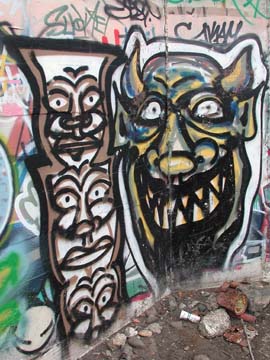
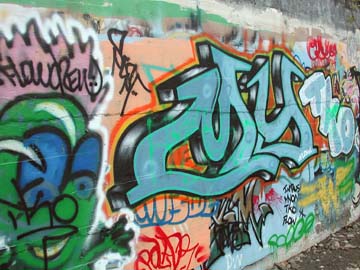
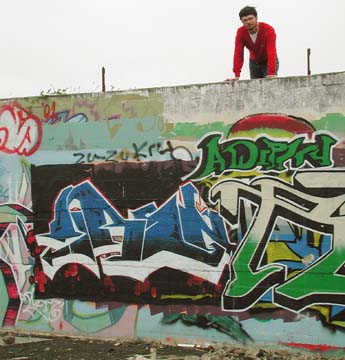
![["SHUN" graffiti ]](cover0122-shun.jpg)
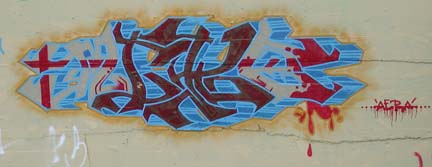
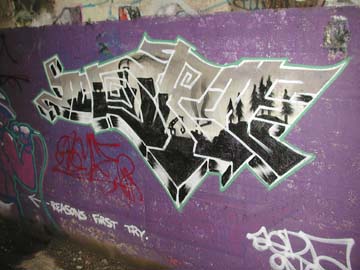
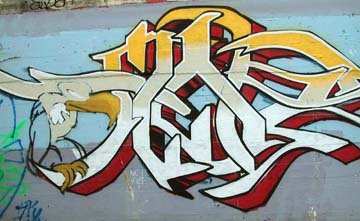

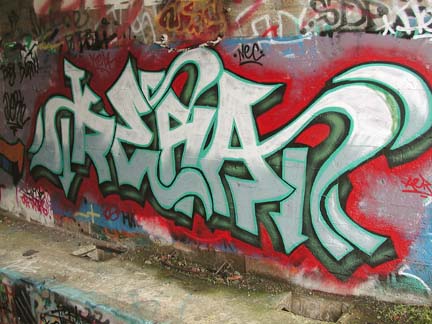
![[graffiti tag MEH]](cover0122-RitasMEH.jpg) When
I showed him a piece of graffiti I had photographed, a tag on
the wall of Rita's Taqueria in Eureka, Elizarraras had no trouble
interpreting it. He explained that the scrawl contained the initials
MEH. [photo at left]
When
I showed him a piece of graffiti I had photographed, a tag on
the wall of Rita's Taqueria in Eureka, Elizarraras had no trouble
interpreting it. He explained that the scrawl contained the initials
MEH. [photo at left]![[graffiti tag "TBK"]](cover0122-TBK.jpg)
![[Graffiti tag: "X4"]](cover0122-x4.jpg)
![[Defaced Del Norte street sign, stop sign with "SUR" tag]](cover0122-SurStop.jpg) He
explains that the numbers 13 and 14, often seen around Eureka,
are shorthand for two rival gangs' names. "The 13th letter
of the alphabet is `M', `N' is the 14th. We're talking about
prisons -- Hispanic gangs in prisons: the Mexican Mafia [Surenos,
the Southerners] and Nuestra Familia, [Nortenos, the Northerners]
-- two gangs that hate each other."
He
explains that the numbers 13 and 14, often seen around Eureka,
are shorthand for two rival gangs' names. "The 13th letter
of the alphabet is `M', `N' is the 14th. We're talking about
prisons -- Hispanic gangs in prisons: the Mexican Mafia [Surenos,
the Southerners] and Nuestra Familia, [Nortenos, the Northerners]
-- two gangs that hate each other."![["WINR" and "ATK" tags on cement]](cover0122-WINR.jpg)
![["Heroe" tag on metal box]](cover0122-heroe-box.jpg)